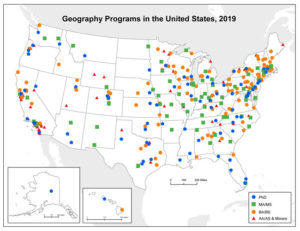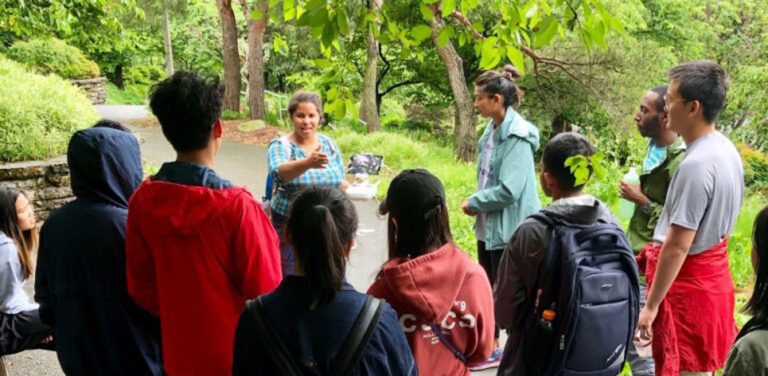Beyond the Academic 1 Percent Or How to Create a More Inclusive and Equitable Academic Culture
 Social media can be dangerous. I recently read a post on Twitter, sent by a non-geographer, which seemed to lament geography’s absence from the Ivy League and similarly selective private institutions.
Social media can be dangerous. I recently read a post on Twitter, sent by a non-geographer, which seemed to lament geography’s absence from the Ivy League and similarly selective private institutions.
If I could share an unpopular opinion, I’m glad that geography does not have a large representation in the Ivy League. Not because I do not consider geography worthy of Harvard, Yale or Princeton. Nor because I don’t think geography should be available to every college student. Rather I dislike how Ivy League institutions foster elitism in American higher education, in a manner that could distort our discipline. One recent essay argued that “Ivy League mania” warps students. And articles have shown how a small group of exclusive universities produce the lion’s share of professors.
It is an academic 1% who gain influence, prestige, and resources far out of balance with the rest of the higher education workforce. Expanded beyond this super elite class, we also have a group—call them the 10%—of professors who are either tenured or tenure track at Research 1 institutions.1 This is followed by another 6% of tenured/tenure-track faculty at other research universities, 10% at bachelors/masters institutions, 5% at community colleges, and 23% of faculty listed as non–tenure track. The rest—almost half— are relegated to part-time status and may have little control over their professional lives and oftentimes suffer living standards close to poverty levels.
Well, geography does not have places like Stanford or Duke calling most of the shots. Rather we are focused at a number of large state universities, some notable private universities, and a host of smaller public institutions and community colleges. And relative to other disciplines, our balance is good. Yet we still suffer issues of inequality. Just as wealth inequality can build upon itself, providing the lion’s share of benefits to those at the top, so can academic inequality engender a privileged class of the professoriate; folks who reap disproportionate benefits of connection, abundant resources, miniscule teaching loads, and who also enjoy the benefit of the doubt because of where they are located. And so much of it depends on luck! I remember a couple of graduate school friends, both with strong and basically identical CVs. One landed a tenure-track appointment at a prestigious flagship university, while the other has been scraping by in adjunct positions. These random outcomes proliferated, affecting each of their professional lives.
The notion of precarity, often affecting those people without stable permanent employment, is worthy of an entire column. As universities shift their hiring away from full-time tenure-track faculty, adjunct labor fills the gaps. Former President Ken Foote has outlined ways that our departments and institutions can support contingent faculty, from offering some degree of stability, to better options to collaborate and contribute to the curriculum and the departmental life. Certainly from an institutional perspective we should find better ways to reward contingent faculty commensurate with their talents.
 Professors lucky enough to obtain full-time employment find themselves in a variety of job environments and at different types of institutions with varied research expectations, teaching loads, and opportunity to mentor graduate students. Some geographers stand alone in a department with other faculty; other geographers are part of a large unit with 20 or more faculty and an opportunity to specialize in their specific subfield.
Professors lucky enough to obtain full-time employment find themselves in a variety of job environments and at different types of institutions with varied research expectations, teaching loads, and opportunity to mentor graduate students. Some geographers stand alone in a department with other faculty; other geographers are part of a large unit with 20 or more faculty and an opportunity to specialize in their specific subfield.
This map displays the diversity of geography programs, based on our development of an extensive database that shows geography programs by highest degree offered.2
The contribution of the smaller departments should not be overlooked. As opposed to many large, research-oriented departments, where much of the focus may be on PhD students, geography at smaller state universities and at private colleges relies on providing a premium student experience with lots of undergraduate engagement, study-away experiences, and tight ties between students and faculty. When attending regional meetings, I often see faculty from these institutions bringing their students to their very first conference. At the same time, a great deal of research gets done by faculty here. They are all expected to publish, many get external grants, and as a bonus, they often share their research experience with undergraduates.
Community colleges are key aspects of our geography universe and they simply do not get the recognition they deserve. We have over 75 community colleges in the United States that offer an associate’s degree in geography (see map). Not only are a plurality of all undergraduate students enrolled in public two-year institutions, but if we are looking at true diversity within our discipline, this is where we start. Undergraduates from poorer backgrounds are much more likely to attend community colleges. African Americans, Native Americans and Latinos also show higher representation at two-year colleges. Beyond community colleges, we should be looking at Historically Black Colleges and Universities as well as Tribal Colleges. These too are intrinsic aspects of our geography universe, and we can expand our numbers by welcoming new geographers from all demographic backgrounds.
The AAG recognizes this institutional diversity in some important ways. There are affinity groups for stand-alone geographers and for community college professors. The AAG has established a Program Excellence Award (just won this year by Lakeland Community College!) and special travel grants for community college students. In addition, we have done a good job in terms of AAG governance. Participation at the Council and on AAG Committees could be a bit more representative, but shows a commitment to institutional diversity.
One example of possible improvement within the AAG lies in the composition of our journals’ editorial boards. Geographers at all types of institutions conduct research and editorial boards ought to reflect this. Yet this is not the case. The composition of the editorial boards of four major AAG journals—The Annals, the Professional Geographer, the AAG Review of Books, and GeoHumanities—shows an overwhelming preference for professors from PhD, mostly R1, institutions. Several institutions like Berkeley and Arizona State have five or more. While professors who teach at non-PhD programs make up well over half of membership, they constitute only 20 percent of all AAG editorial boards. The distribution is lopsided enough that a colleague of mine was discouraged from applying for an editorial position because their type of institution was not represented on the editorial board. This is a persistent bias and one I am guilty of myself.
Geography in the United States does not have a 1%. We have no academic over-class gazing down from the Olympian heights of the Ivies and Ivy-adjacents. But we do have a privileged 10–15% slice of tenured faculty at PhD-granting institutions and especially at Research 1 schools. It is important that we recognize the very inequalities that exist within our field. Geography, and the AAG as its premier organization, needs to improve its record on institutional diversity. It means that the field must work harder to expand the community of geography by aggressively including faculty who work at smaller institutions, often as stand-alone geographers, at HBCUs, and at community colleges. It means departments must consider hiring PhD students who come from a variety of institutions, if their CVs warrant. It means that, as with many forms of inequality, people of good will can blindly reinforce the advantages accrued to a very few members of our discipline. It is time for us to acknowledge our privilege and truly open up our field to the widest numbers of geographers.
1 This data is derived from National Center for Education Statistics. The breakdowns by faculty workforce were provided to me by the American Association of University Professors.
2 Map created by Jessica Reese. This is based on a database developed by myself and Fiona Allan of all departments providing some sort of geography degree. Some departments are listed as offering a PhD even if it is in a fairly specialized area. Let me know if you see any omissions and I will add these to the database.
— Dave Kaplan
AAG President
DOI: 10.14433/2017.0067

